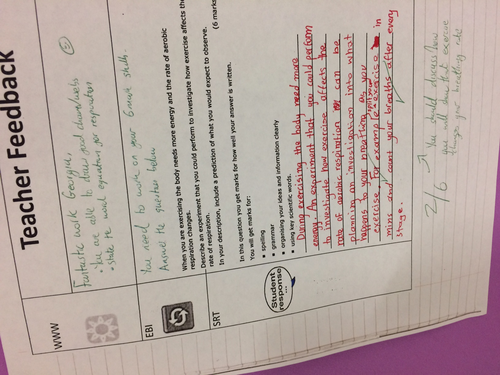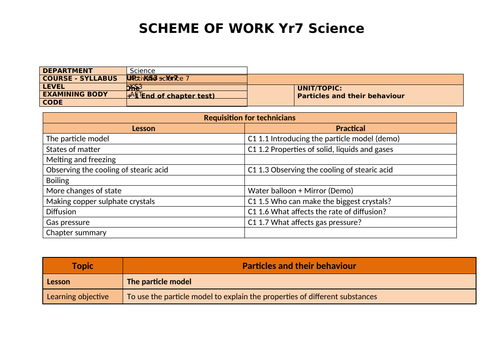243Uploads
111k+Views
55k+Downloads
Chemistry

Rutherford & The Nuclear Model
In this lesson, learners discover how Rutherford and his students deduced the nuclear model from the alpha scattering experiement.

J J Thomson & Plum Pudding Model
Learners will discover how JJ Thomson came up with his Plum Pudding Model and will also see how Millikan discovered the charge of the electron.

Atomic Theory
In this lesson, learners will learn about the billiard ball model, plum pudding model, nuclear model and Bohr model of the atom.
They will also learn the contribution of James Chadwick and how to distinguish the different sub-atomic particles.

KS4 Chemistry 1 Marking and Feedback Exam questions with Answers (Formative assessment)
I’ve uploaded an image of the finished product.
This should be used ideally as a formative assessment before the summative assessment.
The teacher (using your school’s designated colour) writes a WWW and relates the EBI to one of the tasks.
The student completes the task using their designated feedback pen.
The teacher follows up and marks the work with comments on how to improve.
Since each unit has four different questions of various abilities, you can also differentiate.
This pack is for Chemistry 1 and included 4 question sheet for these units:
C1 Atomic structure
C2 The periodic table
C3 Structure and bonding
C4 Chemical calculations
C5 Chemical changes
C6 Electrolysis
C7 Energy changes

Yr7 Particles. Scheme of Work for Kerboodle Activate 1 (SoW)
Content
Lesson objective
Skills objective
Learning outcomes
Keywords
Numeracy
Practical
Homework
Misconceptions
Key questions to ask
Lesson plans:
The particle model (Practical)
States of matter (Practical)
Melting and freezing
Observing the cooling of stearic acid (Practical)
Boiling
More changes of state (Practical)
Making copper sulphate crystals (Practical)
Diffusion (Practical)
Gas pressure (Practical)
Chapter summary

C14.2 Water safe to drink
AQA GCSE Sciences (9-1)
Chemistry: C14 The Earth’s resources
Lesson 2: C14.2 Water safe to drink
Based on the Kerboodle Resources
The AQA Kerboodle worksheet are not included so as to be acting within the TES code of conduct.

C14.1 Finite and renewable
AQA GCSE Sciences (9-1)
Chemistry: C14 The Earth’s resources
Lesson 1: C14.1 Finite and renewable
Based on the Kerboodle Resources
The AQA Kerboodle worksheet are not included so as to be acting within the TES code of conduct.

C13.5 Atmospheric pollutants
AQA GCSE Sciences (9-1)
Chemistry: C13 The Earth’s atmosphere
Lesson 5: C13.5 Atmospheric pollutants
Based on the Kerboodle Resources
The AQA Kerboodle worksheet are not included so as to be acting within the TES code of conduct.

C13.4 Global climate change
AQA GCSE Sciences (9-1)
Chemistry: C13 The Earth’s atmosphere
Lesson 4: C13.4 Global climate change
Based on the Kerboodle Resources
The AQA Kerboodle worksheet are not included so as to be acting within the TES code of conduct.

C13.3 Greenhouse gases
AQA GCSE Sciences (9-1)
Chemistry: C13 The Earth’s atmosphere
Lesson 3: C13.3 Greenhouse gases
Based on the Kerboodle Resources
The AQA Kerboodle worksheet are not included so as to be acting within the TES code of conduct.

C13.1 History of our atmosphere
AQA GCSE Sciences (9-1)
Chemistry: C13 The Earth’s atmosphere
Lesson 1: C13.1 History of our atmosphere
Based on the Kerboodle Resources
The AQA Kerboodle worksheet are not included so as to be acting within the TES code of conduct.

C12.5 Tests for negative ions
AQA GCSE Sciences (9-1)
Chemistry: C12 Chemical analysis
Lesson 5: C12.5 Tests for negative ions
Based on the Kerboodle Resources
The AQA Kerboodle worksheet are not included so as to be acting within the TES code of conduct.

C12.4 Testing for positive ions
AQA GCSE Sciences (9-1)
Chemistry: C12 Chemical analysis
Lesson 4: C12.4 Testing for positive ions
Based on the Kerboodle Resources
The AQA Kerboodle worksheet are not included so as to be acting within the TES code of conduct.

C12.3 Testing for gases
AQA GCSE Sciences (9-1)
Chemistry: C12 Chemical analysis
Lesson 3: C12.3 Testing for gases
Based on the Kerboodle Resources
The AQA Kerboodle worksheet are not included so as to be acting within the TES code of conduct.

C12.2 Analysing chromatograms
AQA GCSE Sciences (9-1)
Chemistry: C12 Chemical analysis
Lesson 2: C12.2 Analysing chromatograms
Based on the Kerboodle Resources
The AQA Kerboodle worksheet are not included so as to be acting within the TES code of conduct.

C12.1 Pure substances and mixtures
AQA GCSE Sciences (9-1)
Chemistry: C12 Chemical analysis
Lesson 1: C12.1 Pure substances and mixtures
Based on the Kerboodle Resources
The AQA Kerboodle worksheet are not included so as to be acting within the TES code of conduct.

C11.2 Condensation polymerisation
AQA GCSE Sciences (9-1)
Chemistry: C11 Polymers
Lesson 2: C11.2 Condensation polymerisation
Based on the Kerboodle Resources
The AQA Kerboodle worksheet are not included so as to be acting within the TES code of conduct.

C11.1 Addition polymerisation
AQA GCSE Sciences (9-1)
Chemistry: C11 Polymers
Lesson 1: C11.1 Addition polymerisation
Based on the Kerboodle Resources
The AQA Kerboodle worksheet are not included so as to be acting within the TES code of conduct.

C10.3 Reactions of alcohols
AQA GCSE Sciences (9-1)
Chemistry: C10 Organic Reactions
Lesson 3: C10.3 Reactions of alcohols
Based on the Kerboodle Resources
The AQA Kerboodle worksheet are not included so as to be acting within the TES code of conduct.

C10.2 Alcohols, carboxylic acids, esters
AQA GCSE Sciences (9-1)
Chemistry: C10 Organic Reactions
Lesson 2: C10.2 Alcohols, carboxylic acids, esters
Based on the Kerboodle Resources
The AQA Kerboodle worksheet are not included so as to be acting within the TES code of conduct.




















